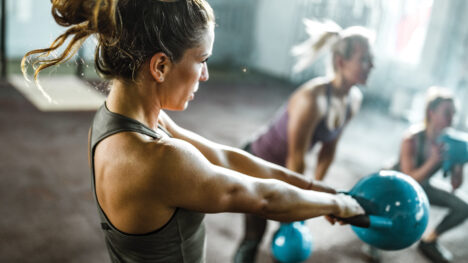
Training and exercising outside, surrounded by nature, can do more than provide you with a change of scenery. It’s also a great way to add variety to your exercise routine while helping you stay enthusiastic about being active.
Some of the benefits of being active outdoors extend beyond the normal positive physical and mental effects of exercise. These added benefits include:
- feeling more motivated to exercise;
- feeling like exercising for longer;
- experiencing calmness and a relief of tension;
- improved mood after exposure to fresh air and natural sunlight;
- improved stress management; and,
- added enjoyment through spending time in pleasant surroundings.
And, of course, outdoor exercise is also inexpensive compared to a gym membership.
So are you ready to take your exercise regime outside? Following are the top five outdoor workouts you can enjoy.
1. Hiking and trekking
The experience of walking in a different and pleasant location helps to keep things new and interesting, making it easier to stick to an exercise program.
In addition to being very enjoyable ways to exercise, hiking and trekking are fantastic fat burners. A hike tends to last longer than a normal exercise walk, helping you to burn significantly more kilojoules. You will burn even more kilojoules if you have a heavier backpack or the hills and terrain you cover are steep and uneven.
Uneven terrain gives your thighs and buttocks a good workout, and it helps to target the stabilising muscles in your abdominal core. This promotes good posture and may help to prevent injury, provided your exercise program remains consistent.
Set a good pace during your walk, swinging your arms and striding out. But be sure to have good quality footwear. If the terrain becomes unstable, shorten your stride slightly to improve your balance. This will still allow you to walk with good speed and rhythm while reducing the risk of a fall.
Drink plain water to stay hydrated, especially if your hike is shorter than 90 minutes. For longer walks, if it is hotter, try a diluted sports drink to boost your energy level and replace electrolytes. The fewer kilojoules you consume, the more fat you’ll burn.
And remember, if you go hiking by yourself, tell somebody the route and the estimated time you expect to return. If the trail is new to you, take a map.
2. Off-road cycling and mountain biking
What’s not to like about getting the wind in your hair and your tyres off-road with some adrenalin-pumping mountain biking?
Cycling is one of the most effective, all-round exercises for aerobic conditioning and fat burning. Like all exercise, cycling boosts your circulation and energy level by increasing your heart’s ability to deliver oxygen to your cells. It also allows you to take in a lot of scenery during the time you exercise, making it a great mind-body experience as well. Outdoor cycling also has a cooling effect, which may encourage you to work out longer than you would when riding on a stationary exercise bike.
Cycling works most of the major muscles in your legs and abdomen without impacting your lower limbs and joints, thus minimising stress and the possibility of injury. Hills and rugged terrain will burn some serious kilojoules while giving you a great abdominal core and cardiovascular workout.
Cycling while seated primarily uses the hip and thigh muscles, while standing works the buttocks and calf muscles. If developing leg strength is your priority, select a higher gear and pedal at a lower cadence. A computerised display can be a helpful accessory, allowing you to monitor your current speed, average speed, distance covered, the duration of your journey and the kilojoules you’ve burned. Models are available that include heart rate.
Don’t forget to take small, regular sips from your water bottle to stay hydrated. You might consider a hydration backpack for rides that last longer than an hour.
3. Paddling
Enjoy the open water and get your body moving by paddling your way to fitness. It’s a great workout for your arms, shoulders and torso, and it will also strengthen your core abdominal muscles. A bonus is that the instability of the water helps to improve your balance.
Because of the upper body focus, paddling minimises the workload on your knees, ankles and hips, which bear the brunt of most land-based exercise. This makes it especially good for runners and cyclists who want to stay fit but who want to take some of the load off their lower body.
There are plenty of options when it comes to paddling, including kayaking, canoeing, stand-up paddling, rowing and dragon boating. Beach lovers can also enjoy a rescue board, wave ski, surf ski or even a surfboard.
“Paddling” is a broad term that encompasses many options, such as single craft, dual-berth craft and team-based activities like dragon boating. It means there’s something for all ages and fitness levels.
It’s estimated that 30 minutes of paddling burns off about 750 kilojoules, making it an effective workout. Beginners are advised to develop their confidence and paddling fitness on flat water and progress from there.
Many places rent canoes and paddleboats, making it possible to enjoy the sport with minimal expense. And at the end of a gruelling workout, when you’re all hot and sweaty, you can jump in the water to cool off!
4. Beach swimming
Swimming is an effective whole-body exercise and it adds variety to any exercise program. It works all your major muscles and places vigorous demands on your heart and lungs without impacting or jarring your joints. Because the water supports your weight, swimming is also beneficial for people who are overweight or pregnant and for those who have knee, hip or ankle problems. It’s also beneficial for those who are recovering from an injury.
Keep your legs taut and your feet flexible, using a scissor-type movement to take advantage of your powerful gluteal muscles. Flippers can also help to build up your endurance if you use them sparingly. They allow you to focus on improving your upper body technique without wearing yourself out too quickly, since you don’t have to worry so much about kicking.
Many beaches have an ocean pool, some of which are ideal for swimming laps. Set yourself some challenges to make your training more interesting, such as a personal best time. Another option is interval training, where you alternate very fast and very slow laps.
Ocean swimming is also growing in popularity, and while it’s more challenging, it’s also more rewarding. Variable conditions in the open sea, with choppy water, wind and waves, mean you’ll have to work harder to get from point A to point B. Improving the quality of your stroke will make a major difference in both your performance and your enjoyment of swimming.
Swimming in the open ocean or in ocean pools is a great way to stay cool while you exercise and enjoy the great outdoors.
5. Outdoor circuits
Any beach, park, lake or open space is the perfect training ground for circuit training. It’s like your own private boot camp. Circuits offer the best of both worlds, helping to strengthen and tone muscles while boosting fitness and burning fat at the same time.
For the cardiovascular component, include activities such as walking, running or swimming. If you have a bike, you could create your own triathlon. Basically, it’s about taking advantage of what’s around you.
For strength training, body weight exercises are ideal. Include exercises such as push-ups, sit-ups, squat jumps, lunges and calf raises. If performed with the correct technique, these exercises can be just as effective as anything you’ll do in the gym, but at no expense. Some areas even have green gyms, with exercise stations strategically located along a walking or running track.
Make sure to start off gradually and build up over time. If you have any concerns about starting a new exercise program, see your doctor.
A Sample of an Outdoor Circuit
- 5-minute walk or jog to warm up
- 10 to 15 push-ups
- 10 to 15 sit-ups
- 5-minute fast walk or jog
- 10 to 15 bench dips
- 10 to 15 bench step-ups (each leg)
- 5-minute fast walk, jog or sprint intervals
- 10 to 15 lunges (each leg)
- 10 to 15 calf raises
- 5-minute fast walk, jog or swim
- 5-minute cool down and stretch
Staying Sun Safe
While the outdoors is a great way to add variety and enjoyment to your exercise routine, it’s also a place where dehydration and heat-induced illnesses can occur.
Consider the following tips before training outdoors:
- Drink plenty of water before, during and after.
- Exercise during the cool part of the day.
- Remember to slip (on a shirt), slop (on the SPf 30+ sunscreen) and slap (on a hat).
- Reapply sunscreen if you sweat heavily.
- Know the signs of dehydration, such as tiredness, nausea and light-headedness.









